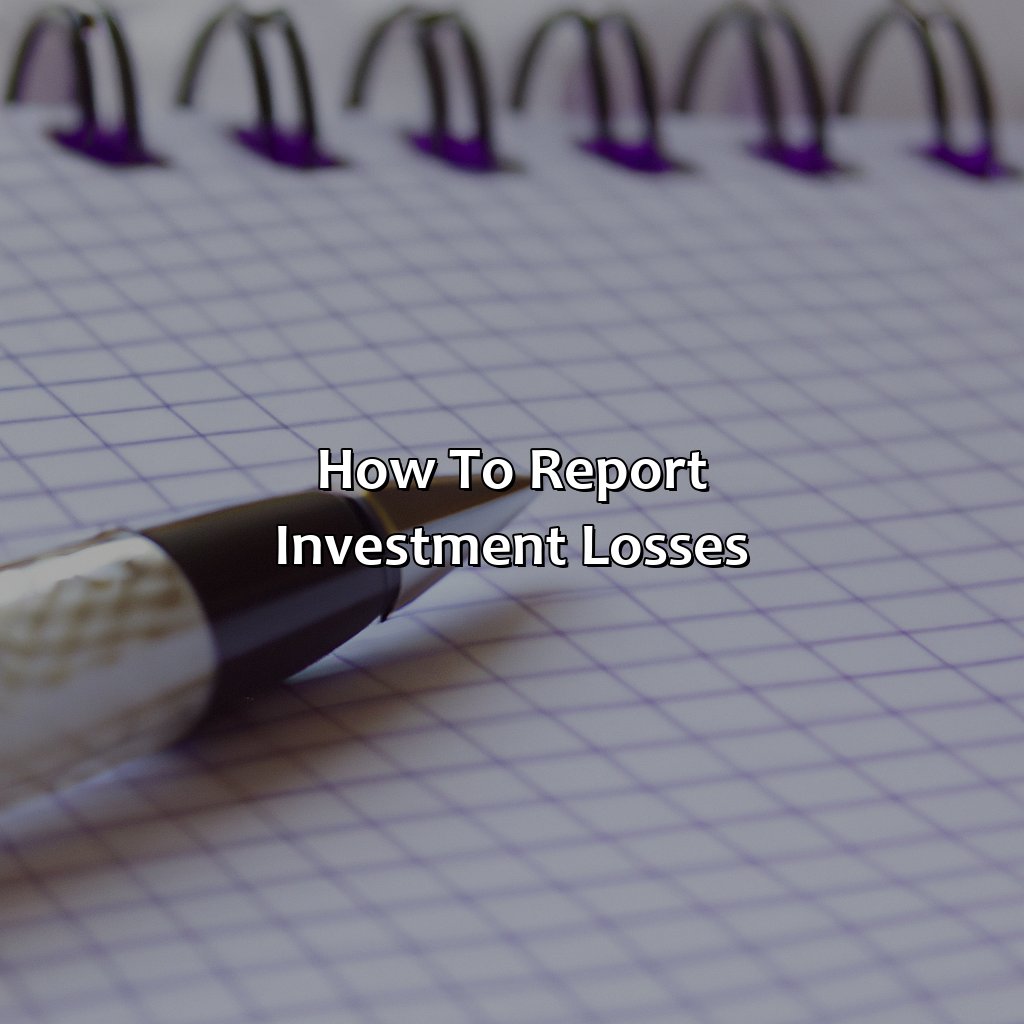How To Report Investment Losses?
Key Takeaway:
- Understanding investment losses is crucial before reporting them. Different types of investment losses include market value losses, realized losses, and unrealized losses, and each requires a different approach.
- Calculating investment losses can be complex, but it’s important to accurately determine the cost basis and adjust for any distributions or dividends received. This will help in reporting the losses to the relevant parties.
- Reporting investment losses may involve filing them on tax returns, reporting them to brokerage firms, or even communicating them to other investors. Seeking professional help can also be beneficial in navigating the reporting process.
Struggling to report investment losses? You’re not alone. Millions of us face this challenge every year, but the right information and guidance can make it easier. With this blog, you’ll learn the ins and outs of reporting investment losses.
Understanding Investment Losses
Gain insight into investment losses as a solution. Take a look at understanding investment losses. Focus on the types of losses and work out how to calculate them correctly.

Image credits: retiregenz.com by Yuval Arnold
Types of Investment Losses
Investment Losses – Overview
Investing in the stock market or other financial instruments always involves some risk. As a result, investors face losses irrespective of their experience level. Let’s delve into different types of investment losses.
Types of Investment Losses:
- Capital Losses: This type of loss occurs when you sell an investment at a lower price than the purchase price.
- Paper Losses: This refers to investments that have lost value but are still held by the investor.
- Opportunity Cost Losses: It refers to potential profits foregone due to missing out on an investment opportunity.
- Taxation-Induced Losses: Taxes can reduce your returns or even create losses if you don’t manage them properly.
- Currency Exchange Rate Losses: Investor faces this loss when they hold investments denominated in foreign currencies and exchange rates change unfavorably.
- Emotions-Based Losses: Making hasty decisions based on emotions such as fear and greed can lead to significant losses.
Additional Information:
Investments come with inherent risks; thus, determining and accepting a reasonable level of risk is crucial while investing. The goal should not be to avoid all kinds of risks but to mitigate and manage them optimally.
Suggestions:
- Diversify Your Investments: Having a well-diversified portfolio across different asset classes, sectors, geographies, and industries helps spread risks effectively, minimizing the probability of large losses.
- Understand Your Risk Tolerance: Identifying individual risk tolerance levels is essential; it avoids taking unsuitable market positions for personal comfort level while investing.
- Professional Advice: A qualified financial advisor can provide insights to avoid making impulsive decisions based on emotional fluctuations in the market, helping optimize investments.
Conclusion:
Good news, math haters – calculating investment losses is basically just subtraction with extra steps.
Calculating Investment Losses
Investment Losses Reporting
Calculating investment losses requires careful evaluation of the financial market, economic indicators and specific investments. Here’s a brief guide to calculate the aforementioned.
- Verify the purchase price: Check for the original cost of the security in question.
- Determine current value: Identify its current worth in the market.
- Calculate differences: Compare both values to calculate gains or losses.
- Deduct selling expenses: Include brokerage fees, taxes and other selling expenses from the total amount received after sale.
- Identifying tax implications: Report net losses or gains on tax returns accurately.
- Keep ongoing records: Monitor investment performance and maintain records for future references.
Further analyzing economic and financial fluctuations over investment good or bad periods can aid in reducing risk associated with potential future losses.
True Story:
Jason, an amateur investor, invested $10,000 in mutual funds that took a downward spiral after 6 months resulting in a loss of $2000. After evaluating similar trends within his chosen market sector and being aware of biases forming due to previous judgement errors, he invested $12,000 into alternative securities subject to new market analysis. His later realization highlights that it is important to be proactive when monitoring your investments; common sense investing could reduce unexpected future losses.
Reporting investment losses is like admitting to your mom that you lost the family silverware after a wild party – it’s painful, embarrassing, but necessary for moving on.
Reporting Investment Losses
Reporting investment losses can be easy! Explore its sub-sections – reporting on tax returns, reporting to brokerage firms and reporting to other investors. These sections provide solutions for reporting losses in various scenarios. This includes tax implications, broker firm policies and investor communication.

Image credits: retiregenz.com by David Duncun
Reporting on Tax Returns
When it comes to filing taxes, it’s important to accurately report your investment losses. This involves providing comprehensive and precise information about the nature of the investment loss and its corresponding value. Failure to do so may result in penalties or investigation by tax authorities.
To ensure accurate reporting on tax returns, individuals should gather all relevant documentation that supports their claim for investment losses. This may include receipts, statements, and other financial records that demonstrate the amount of loss incurred.
Additionally, investors must differentiate between long-term and short-term capital gains/losses before reporting them on their tax returns. Proper classification ensures accurate calculation of taxes owed.
Reporting to your brokerage firm is like telling your boss you lost the company car – awkward and potentially costly.
Reporting to Brokerage Firms
Reporting investment losses to your brokerage firms is crucial to keep track of how your portfolio is performing. Here’s what you need to know:
- First, make sure to provide accurate and timely information about the losses incurred. You can do this either through a customer service representative or by submitting a written request.
- Second, understand the process and documentation required, such as account statements, trade confirmations, and tax forms. These details will help you accurately report to your brokerage firm and minimize any further losses.
- Third, consider seeking professional advice from financial advisors or tax professionals who can guide you in navigating the reporting process.
It’s worth noting that prompt reporting of investment losses will ensure that your brokerage firm takes corrective action and helps prevent future losses. Remember to check with your broker for specific guidelines on reporting investment losses effectively.
Share the bad news like a bad breakup – be honest, direct, and don’t drag it out.
Reporting to Other Investors
As an investor, it’s essential to share your portfolio performance with others. This may include sharing investment losses, which can be crucial for reporting accurate data and maintaining transparency. Other investors may evaluate the performance of different portfolios before making investment decisions- therefore, sharing loss information is crucial.
When reporting investment losses to other investors, one should ensure to present data in a clear and concise manner using graphs or charts if possible. It’s vital to explain reasons for decline or loss of investments in detail. By doing so, the investor demonstrates a comprehensive understanding of their portfolio while also showcasing transparency.
Investors must emphasize the negative aspects while simultaneously pointing out the strengths- this enables investors to identify areas that need improvement and strategies that generate profits while minimizing losses. When reporting investment losses, one should also highlight opportunities for growth within the current market conditions.
In 2008, during the global financial crisis, numerous companies failed because they concealed their financial losses-resulting in mistrust among investors. Since then, regulations have been established obligating firms and individuals to present accurate information regarding investments transparently. As such, failure to report accurate loss information is punishable by law- underscoring its significance in investing practices today.
Because let’s face it – sometimes even Google can’t solve all your problems, especially when it comes to reporting investment losses.
Seeking Professional Help with Reporting Investment Losses
Investment losses can be reported with the help of professionals who specialize in handling tax and financial matters related to investments. Seeking the guidance of an experienced professional can ensure that all the necessary documentation and forms are submitted accurately and on time. This can save time and reduce the risk of errors that can lead to penalties or audits. In addition, tax and financial professionals can help investors identify potential tax deductions and credits that can offset investment losses and reduce their tax liability.
Professional assistance can be particularly important for investors who have experienced significant losses or have complex investment portfolios. Tax rules and reporting requirements can be difficult to navigate, especially for those who do not have a background in finance or accounting. A professional can help investors understand their options and develop a strategy that fits their unique needs and circumstances.
It is worth noting that while professional help can be beneficial, it comes at a cost. Investors should be prepared to pay for the expertise and services of a tax or financial professional. However, the potential benefits of reducing tax liability and avoiding costly errors may make it worthwhile.
According to the IRS, investors can generally deduct investment losses up to $3,000 per year, or $1,500 if married and filing separately. Losses that exceed these limits can be carried over to future years. It is important to report investment losses accurately and in a timely manner to take advantage of these deductions.

Image credits: retiregenz.com by Harry Washington
Five Facts About How To Report Investment Losses:
- ✅ Investment losses can be reported on Form 8949 and Schedule D of the federal income tax return. (Source: IRS)
- ✅ Capital losses can be used to offset capital gains, and up to $3,000 of net capital losses can be used to offset other types of income. (Source: Investopedia)
- ✅ Losses from the sale of cryptocurrency can also be reported on Form 8949 and Schedule D. (Source: CoinDesk)
- ✅ It’s important to keep accurate records of investment transactions and their associated costs in order to properly report losses. (Source: The Balance)
- ✅ If you have a substantial amount of investment losses, it may be wise to consult with a tax professional for guidance. (Source: Forbes)
FAQs about How To Report Investment Losses?
How do I report investment losses on my taxes?
To report investment losses on your taxes, you need to file a Schedule D (Form 1040) with your tax return. You need to list each investment you sold at a loss and report the total loss for each investment. The total loss is then deducted from your overall capital gains for the year.
Can I deduct all of my investment losses on my taxes?
No, you can only deduct up to $3,000 in investment losses per year. However, any losses that exceed this amount can be carried forward to future tax years.
What if I have both investment gains and losses in the same year?
If you have both investment gains and losses in the same year, you will need to report them separately on your tax return. Report your gains on Schedule D, and your losses on Form 8949. You will then be able to offset your gains and losses when calculating your total capital gains for the year.
Do I need to include documentation of my investment losses when filing my taxes?
You do not need to include documentation of your investment losses when filing your taxes, but you should keep records of all your investments and losses in case the IRS asks for proof of your deductions.
What if I have investment losses from a partnership or S corporation?
If you have investment losses from a partnership or S corporation, you will need to report them on your tax return as a pass-through deduction. The losses will be reported on Schedule K-1 and then allocated to each partner or shareholder based on their percentage of ownership.
What are the benefits of reporting investment losses on my taxes?
Reporting investment losses can help reduce your overall tax bill and potentially result in a refund. Additionally, carrying forward losses to future tax years can provide a tax benefit in the future.
